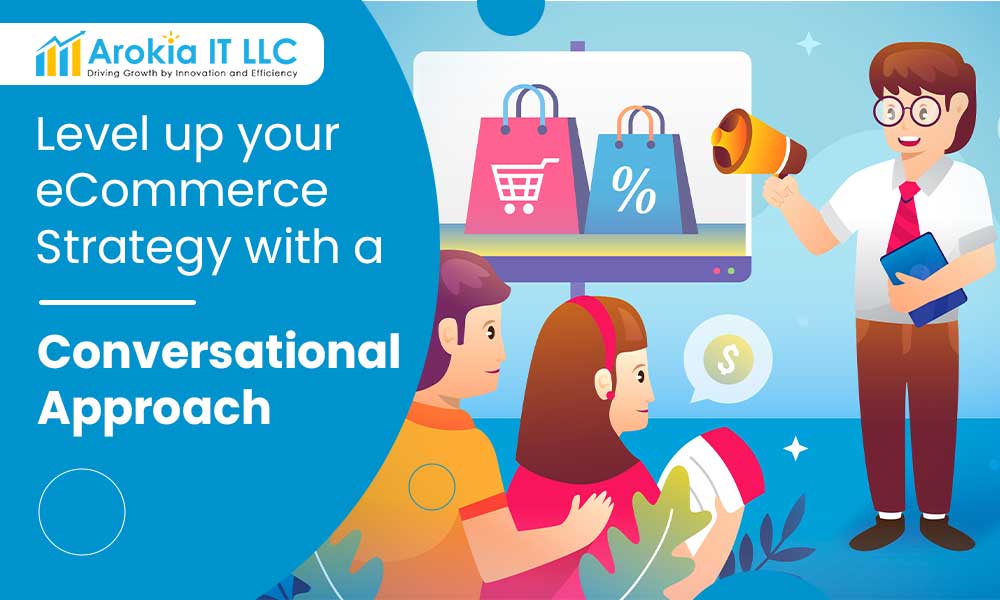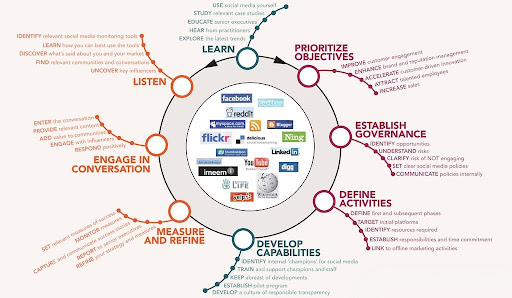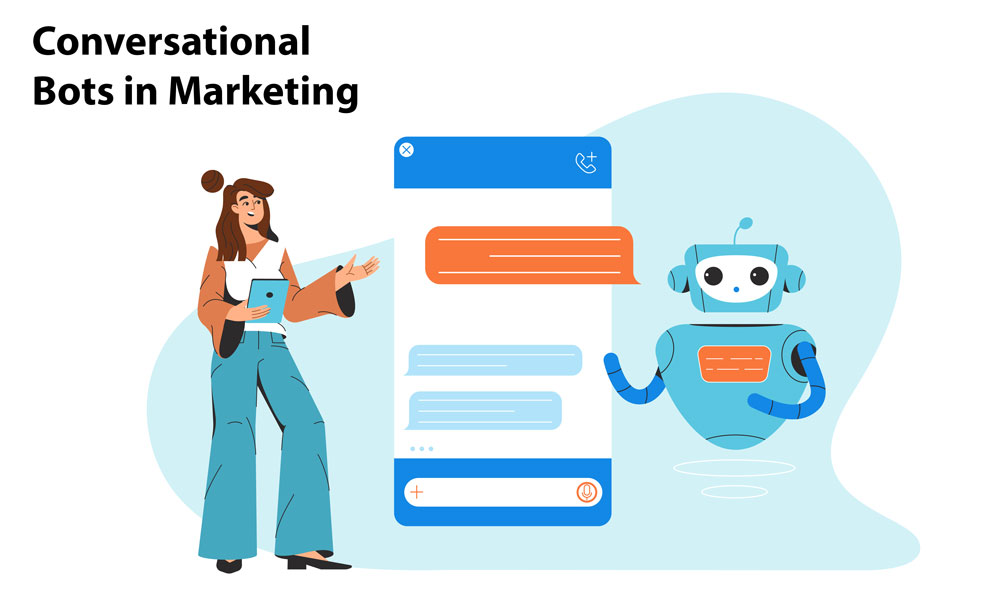Level up your eCommerce Strategy with a Conversational Approach
Why Conversational Marketing is important for your business?
Conversational marketing is a form of relational and digital marketing. It allows companies to build stronger and long-lasting relationships with their customers through automated, real-time conversations on social media or the company’s website. Email campaigns, FAQs, forms, and chatbots are perfect examples of conversational marketing tools.

Conversational marketing is revolutionizing the way customers buy. At the core of conversational marketing is building relationships through dialogue with your customers. It is based on one-to-one interactions in real-time across multiple channels. It has become the go-to strategy
- For driving customer engagement,
- Improving customer experience, and
- Growing revenue.

While building relationships and collecting data, conversational marketing tools light up your lead generation numbers and shorten your sales funnel, with less manual effort. Live chat, chatbots, and messaging apps are used to enable these personalized conversations.
Any form of two-way communication, like phone and email, can be part of a conversational marketing strategy.
Although today, messaging is the most popular way to get in touch and reach out to customers. People love to chat and want instant responses, which is part of the reason why messaging apps like WhatsApp are so popular.
Best conversational marketing tools to start with
There are tons of different tools you can use for conversational marketing. Here is a brief list of conversational marketing software you can look to get started with:
- Chatbots
- Live chat
- Multi-step forms
- Interactive Ads
Starting with any of these tools is a great way to get your foot in the metaphorical door of conversational marketing. Before zeroing in on which tools might work best for your business, consider the leading conversational marketing trends.
What is Conversational Messaging?
- Conversational marketing is closely related to conversational messaging. The former is the strategy, while the latter is the execution.
- Messaging experienced the biggest surge in popularity of any customer service communication channel over the last year.
- Most conversational marketing occurs through some sort of messaging channel — whether that’s webchat, in-app messaging, SMS/text, or social messaging apps like Facebook Messenger and WhatsApp.
- “Conversational messaging is basically a way of meeting your customers right where they are,”. Whether they’re on your website, on your mobile app, or on social channels, if your customers try to get ahold of you, you’re available to them.”
What are Conversational Bots in Marketing? The Effortless Star of your show

- If you’re using messaging to do conversational marketing on your website, you’re going to need to collect data from each visitor in order to follow up with them and start a dialogue with them. And a chatbot is an easy way of helping to facilitate that.
- A chatbot is a good “first line of defense” for connecting with customers.
- You can program bots to answer a lead’s preliminary questions and gather their information.
- Eventually, if the lead says they want to speak with a sales rep, the bot can hand them off to one of your agents. The agent will be able to see the full interaction history, giving them the context they need to jump into the conversation.
You can also program a conversational marketing chatbot to automatically monitor important behavioral details of website visitors, including their
- Visited webpages
- Abandoned carts
- Web browser
- Geolocation and the chosen language
And that’s just the “lead capture” application of conversational marketing chatbots. There are various types of chatbots a company might use over the course of the customer lifecycle, from sales to support. They do the heavy lifting to qualify leads so you can grab those leads while they’re hot. The best bots can be customized, simplified, and even gamified all in one place.
A custom-branded chatbot entices the viewer to the corner of the screen to make navigating your website so much easier. And for you, this means they shoot through the sales funnel faster and the qualifying process is frictionless.
Chatbots
- Help provide 24/7 lead generation and support
- Increase conversions by promoting your lead magnets
- Gather data and contact information
- Qualify your leads better
- Personalize your customer experience
Why is Conversational Marketing essential to your business?
- To create human bonds with their customers: Having conversations with your website visitors helps you to learn more about their needs and pain points, and collect the information you need to qualify them further. Based on what they’re interested in and where they’re in their buyer’s journey, you’ll be able to adjust your communication, send them relevant, targeted messages and interact with them in a meaningful way.
- Convert leads: It helps in improved lead generation. Conversations not only help you convert leads but also qualify them for your sales when you’re asking the right questions at the right time.
- Move buyers through your sales funnel faster.
The Base of conversational marketing
Conversational marketing is originally based on three pillars without which it would not exist nor could it be incorporated into a business’s marketing strategy.
- Multiple channels of communication: These conversations happen by email, by phone, and more recently via a plethora of different tools such as social media, apps, and websites. By being present on various communication channels, companies can have an impact and attract people from multiple age groups and backgrounds.
- Instantaneity and interactivity: With the development of the internet and instant messaging, the demand for interactive services and spontaneous conversations have become more and more widespread. Customers like to get precise information quickly and it has become a requirement in order for businesses to grow customer relationships.
- The evolution of new technologies: Without the invention of new technologies and new ways of communicating (such as emails, text messages, social media, etc.), conversational marketing would not exist or would at least not be as widespread. Future evolutions in the sector of new technologies will most certainly develop conversational marketing and make it even more widespread.
When buyers want what they want now – How do you (Actually) do conversational marketing?
Engage – It's time to start engaging with buyers anytime they're ready to start a conversation.

Today, buyers want to engage with a business whenever and however they desire. They have less patience and less tolerance for mistakes. They want what they want right away.
It could be learning about your product, getting a simple question answered, or purchasing your product – buyers want what they want now. They expect to receive an experience that’s simple and helpful, and they certainly don’t want to be blocked when trying to get answers.
They want to be able to engage with your business on their terms no matter the medium – your website, email or messaging. By using a combination of real-time messaging and chatbots on your website, you can easily replace lead capture forms with conversations.
Understand – you can build more trust with buyers if you can help them better understand what you offer and how you can solve their needs.
Buyers have more information at their fingertips than ever before. Buyers have been trained to seek out information and facts before they engage in a conversation with you. They might understand more about what you do, why you do it, and what you sell than even the salesperson. They understand how marketing and sales work today. They want to be treated like a human and not an email address that you’re trying to qualify for. The more shared understanding created between seller and buyer, the more trust you’ll create. Building and deepening the trust you develop with each buyer should be top of mind.
Recommend – Making the right recommendations can lead the buyer to become a customer.
Buyers want honest and helpful recommendations. Recommendations and reviews from people have become a key part of the buying experience. Buyers turn to their networks of friends, family, and customers to learn if they should purchase your product. They don’t want to be oversold.
They want the recommendation you share to be useful. No matter if that’s a video to watch, a piece of content to read, or the product they should purchase. Today buyers don’t tolerate mistakes or bad recommendations. The more helpful the recommendation, the more trust will be developed and the higher the chance the relationship you’ve built will last.
Conversational Marketing Strategy

Target your conversational marketing tools
It starts with selecting the website pages where you want your conversations to take place. Leverage your pages based on where you receive the most leverage your pages based on where you receieve the most traffic, and where you have high-intent visitors that are most likelyy to make a purchase.
To optimize your results, place the chatbot on the pages that both get high levels of traffic and convert well.
Plan your conversation flow
It should be based on the strategy you’ve chosen and the phases of the customer journey of your website visitors.
The number of questions and the type of things you should ask will vary according to the customer journey.
Keep it simple and casual
Try to keep your interactions simple in your planned conversation flows and at all stages of the customer journey. Making it too complicated can lead to drop-offs and misunderstandings.
Greet and guide visitors
Your bot can open as a pop-up to welcome and greet first-time visitors when they arrive on your website. And, when they’ve shared their contact information and become regular visitors, you can continue to welcome them with a more personalized message based on the information you’ve gathered on their path while on your site.
Educate with lead magnets
People who are in the awareness stage of their customer journey and looking to educate themselves when they land on your site will be pleasantly surprised if your chatbot provides them content on a topic they’re interested in. At the same time, you can capture a new lead as your bot collects your visitor’s contact information.
Promote your offering and demos
Some of your visitors may have a problem when they come to your website, and they know that your company offers a solution to this problem. That is a great opportunity to use your bot to find out what the problem is and to promote your products or services and guide the visitors to your offering.
Ask for feedback
And lastly, don’t forget to use your bot to take the opportunity to ask for feedback from your customers and prospects whenever having a conversation with them.
Benefits of conversational marketing
- You create a more human buying experience: Improve your customer experience: conversational commerce has the power to help improve the checkout journey, site navigation, and overall customer experience. You learn a lot about your buyers and customers.
- Increase engagement and interaction: Conversational commerce helps make your brand more accessible to consumers, by expanding your channel mix. This makes it easier for customers to reach you and interact with your brand.
- You convert more leads and better leads.
- You shorten your sales cycle.
- You grow your sales pipeline and boost your online sales: Conversational commerce provides the possibility to grow your business and increase online sales by helping up-sell and cross-sell products. At the same time, it can help automate parts of your customer service, helping drive your costs down.
The ultimate goal of these conversations is of course to collect contact information and qualify your leads further to take them smoothly through your sales funnel. Bots are there to do it proactively in their approachable and human way even during out-of-office hours when your teams are not available. Conversational commerce can help optimize your customer experience, increase online sales, and improve the way consumers interact with your business during the entire buying process.
Conversational marketing tools
- WPForms Conversational Forms Addon
- Facebook Messenger Bot
- Chatfuel-Chatfuel is a plugin that helps you build bots for Facebook Messenger. However, it doesn’t work with other platforms (like WordPress).
- Botfuel: Botfuel is a platform that lets you build and manage conversational Chatbots based on info in your database.
- Drift: Drift makes it easier for people to buy from your business by using conversations. So when you connect Drift’s conversational marketing platform to your site, you can get more qualified leads using bots. And bots also help book meetings with your team members.
- Other conversational marketing tools that are enterprise-friendly include, Hubspot, Intercom, Conversica, Siftrock, ManyChat.
Some examples of conversational marketing
Sephora and the Virtual Artist
A French multinational chain of cosmetics and beauty care products favorite of every makeup enthusiast. A huge chunk of its credits goes to the exceptional marketing campaigns by their team. Sephora recently leveled up its marketing game with their Virtual Artist. This AI-powered Facebook Bot lets the prospects try on the makeup. The user just has to upload her selfie and apply different products to the picture. The bot then streamlines the thread so that the prospect can directly buy the products.
Lyft and the Lingering Chatbots
An American company that offers Vehicles for hire, commute, and food delivery. The company stands for some incredible causes like carbon emission reduction, etc. It is their incredible customer service that made it appreciated by everyone in the US.
Lyft took this very quality of theirs to another level with their customer service chatbots posted on various channels including Facebook Messenger Slack Amazon echo X etc. So in case you are currently using your phone, you can just type Lyft in a chat channel and you will be able to avail the ETA, vehicles, and fares.
This is an attempt by the company to make booking super duper easy for everyone. After you request a ride the chatbot will also notify you about the status of your ride and the details of the driver on whichever app you are on.
National Geographic and Albert Einstein: In 2017 the channel launched a new show ‘Genius’, an anthology about Albert Einstein. For promoting the show and creating awareness among the audience, the channel opted for some fun conversational marketing through Facebook messenger.
Any user Who texted the channel on Messenger received witty answers in the voice of Albert Einstein. The campaign was one-of-its-kind and gained crazy attention with 50% of users re-engagement. eBay and “Okay Google….”: eBay, the e-commerce biggie uses conversational marketing to enhance the shopping experience of the user by deeply understanding the requirements. Anyone can shop from the large inventory of products on eBay through voice assistants. All you have to say is “Okay Google, ask eBay to find me…” The virtual assistant then goes about and looks for the most relevant results for your search terms.
It then gives you the choice to import these options into your smartphone so that you can go ahead and make the purchase.
Domino’s – Order from Anywhere: Domino’s marketing strategies are hands down, one of the finest. One such amazing conversational marketing tactic was Domino’s AnyWare. It all started with the consumers tweeting an emoji and receiving a Domino’s pizza delivery. It then transformed into something bigger. The food chain now lets you order pizza from literally any app that you’re using. Be it Slack, Alexa, Facebook Messenger, or Twitter, you ask for a pizza and Domino delivers it.
Marvel and Automated Ticket Booking
Marvel certainly has a few of the highest-selling movies in the history of Hollywood. Marvel’s fans and merchandise are literally everywhere. Yet this media franchise biggie used conversational marketing for selling tickets for the movies Avengers: Infinity War and Antman and the West.
The promotions continued to go on on social media but with the element of automatic checkouts. Every time a person commented on the promotional post, she would trigger a Chatbot that would direct them to the customer details and payment page. This method is by far one of the most non-conventional methods used by any company ever. The fruition of these efforts are the increased conversion rate of 68%.
Here are the most common questions we get related to conversational marketing.
You can measure your conversational marketing efforts just like you would measure any other marketing channel. Drift’s conversational marketing platform gives you dashboards that show you how many leads you’ve captured and qualified with conversations, how many meetings you booked and scheduled, and how much revenue and pipeline your conversations are driving. You can even see the total amount of sales opportunities influenced.
When we analyzed the data from the 50,000+ businesses using Drift for conversational marketing, we found that people in key decision-making roles are often the ones choosing to connect with businesses via real-time messaging.
Yes! One of the most popular applications of conversational marketing is to help reduce the friction of customer support experiences, finding the right support documentation to self-help, and improving all-around customer experience.
Bots allow you to offer fast responses to visitors 24/7, even while your team is sleeping. Since they can ask the same qualifying questions your sales reps normally would, they can figure out who’s qualified to talk to sales and connect them to the right person. Chatbots have become so effective at these types of conversations that they now manage over 50% of all the conversations we have at Drift. Traditional marketing is mostly used to talk about offline advertising strategies such as publishing in newspapers, sending emails, or covering street walls with posters. Today, in the age of ultra-connectivity on the Internet, marketing has evolved and new types of marketing have appeared. Companies must think about implementing conversational marketing in their business to create human bonds with their customers. Implementing conversational marketing doesn’t force you to blow everything up and start from scratch. It’s the fastest way to move buyers through your marketing and sales funnel. It’s more like turning on a new lead-gen channel that complements your existing marketing efforts.
Change is the only constant thing in SEO. It is estimated that Google updates its algorithm on a daily basis, so the underlying rules change roughly 365 times each year. But rest assured as it is only the major updates that will impact us the most and that is what we will keep keeping tracking here as well.
A Google algorithm update is a modification made to Google’s search engine with the aim of improving the quality, relevance, and user experience of its search results. Google’s search algorithm, PageRank, is designed to rank web pages in their search engine results by measuring the importance of website pages.
- In March 2023, Google released its latest core algorithm update, which will target all types of content across all regions and languages to promote high-quality or high-value web pages. Although these updates can have a significant impact on search rankings, Google has stated that they do not target specific pages or sites.
- Major Google algorithm updates are changes to the search engine that will likely affect the search engine results page. Google updates aim to improve their search results and as a result, they want to rank higher sites that are relevant, high quality, up-to-date and unique. It is then important to understand what each Google update is all about so that, you can ensure that your website is not on the wrong side of the update, thus affecting your search rankings in the search results.
- To prepare for future algorithm updates, it is crucial to prioritize user experience and provide valuable content. Website owners and SEOs must also monitor site metrics, such as organic search traffic and keyword rankings, to assess the impact of the update and identify areas for improvement.
Kalyan Tirunelveli
Author
- Best conversational marketing tools to start with
- What is Conversational Messaging?
- What are Conversational Bots in Marketing? The Effortless Star of your show
- Why is Conversational Marketing essential to your business?
- When buyers want what they want now – How do you (Actually) do conversational marketing?
- Conversational Marketing Strategy
- Benefits of conversational marketing
- Some examples of conversational marketing
- Here are the most common questions we get related to conversational marketing.
